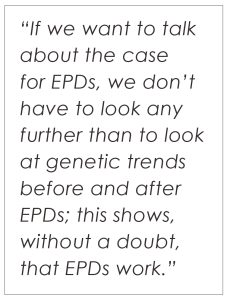Three influential producers from the United States and Canada came together for an impactful panel discussion on “A Business Case for Using EPDs” during the 2023 BIF Annual Symposium’s Advances in Producer Applications breakout session on Tuesday, July 4. Dr. Darrh Bullock, University of Kentucky, moderated the panel, which included Paul Bennett from Knoll Crest Farm, Red House, Virginia; Sean McGrath of Round Rock Ranching, Vermilion, Alberta, Canada; and Donnell Brown, RA Brown Ranch, Th rockmorton, Texas.
The panelists were charged with describing their philosophies on using expected progeny differences (EPDs). Brown referenced genetic trends over time, pointing out, “If we want to talk about the case for EPDs, we don’t have to look any further than to look at genetic trends before and after EPDs; this shows, without a doubt, that EPDs work.” Bennett discussed the collaborative relationship between breed associations and producers to generate high-quality selection tools. “Genetic evaluations rely on clean, comprehensive data. As a seedstock producer, I am responsible for contributing the highest quality data so that the EPD that comes out is as good as possible,” he said.
 All the panelists were clear that EPDs help them move the needle on genetic improvement, but they’re ultimately risk management tools for commercial customers. McGrath summed this up well, saying, “There is a big difference between being a bull seller and a seedstock service provider.” Bennett emphasized that seedstock producers must “quantify the product we sell to our commercial customer.
All the panelists were clear that EPDs help them move the needle on genetic improvement, but they’re ultimately risk management tools for commercial customers. McGrath summed this up well, saying, “There is a big difference between being a bull seller and a seedstock service provider.” Bennett emphasized that seedstock producers must “quantify the product we sell to our commercial customer.
We need to know what our cattle can and can’t do for our customers.” Similarly, Brown said he wants “as many tools [EPDs] as he can have in his toolbox to make the optimal breeding decision to deliver that promise to his customers.” While each panelist underlined the importance of needing a diverse set of tools in the form of EPDs, they also underscored the challenge for their customers in interpreting the full array of tools available now. Bennett commended breed associations for the job they have done in developing and optimizing selection indexes for commercial settings and simplifying data analysis. He said that Knoll Crest has altered how they deliver EPD information to their customers. “We are careful in how we present data to our customers,” he explained. “Our catalogs have evolved over time, and we’ve worked to optimize the data we put in front of our customers to prevent information overload.”
McGrath also discussed the importance of seedstock providers communicating to their customers about which index best fits their business plan. The other central theme panelists covered was how EPD profiles are not one size fits all. McGrath talked about his operation’s unique breeding goals. “I want to have a $1,000 gross margin per cow, eliminate cow herd depreciation and to do so without interference – 10 minutes per year, per cow,” McGrath explained. His primary use of EPDs is to match complementary genetics that can handle their unique and harsh production environment. McGrath emphasized that his ideal EPD profile may not be optimal for another ranch. He noted that knowing the needs of each business and which traits should be focused on are important when discussing EPDs.
Brown noted that today’s cattle have “big engines, sometimes bigger than our production environments can handle. This creates a case where we have to be conscientious of how we make cattle that match our production environment as well as our business plan.” One question posed to the panel was regarding their thoughts on a needed EPD that has not yet been developed. Bennett mentioned a methane EPD while McGrath expressed a need for a grazing functionality trait or index. Brown suggested an index or measure of an animal’s ability to have a multi-breed index for lifetime-sustained profitability. Th is producer panel provided various insights into how the industry can effectively put EPDs to use. Brown offered a recipe for continued genetic progress, saying, “Without EPDs, we’re driving blind from a genetic perspective. Using EPDs doesn’t mean we’ll always make the right decisions. It just means we’ll make the right ones more often than the wrong ones.”
For more information about this year’s Symposium and the Beef Improvement Federation, including additional presentations and award winners, visit BIFSymposium.com











